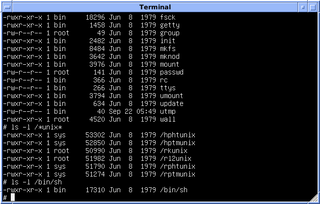
Bash is a Unix shell and command language written by Brian Fox for the GNU Project as a free software replacement for the Bourne shell. First released in 1989, it has been used as the default login shell for most Linux distributions. Bash was one of the first programs Linus Torvalds ported to Linux, alongside GCC. A version is also available for Windows 10 and Windows 11 via the Windows Subsystem for Linux. It is also the default user shell in Solaris 11. Bash was also the default shell in versions of Apple macOS from 10.3 to 10.15, which changed the default shell to zsh, although Bash remains available as an alternative shell.

KornShell (ksh) is a Unix shell which was developed by David Korn at Bell Labs in the early 1980s and announced at USENIX on July 14, 1983. The initial development was based on Bourne shell source code. Other early contributors were Bell Labs developers Mike Veach and Pat Sullivan, who wrote the Emacs and vi-style line editing modes' code, respectively. KornShell is backward-compatible with the Bourne shell and includes many features of the C shell, inspired by the requests of Bell Labs users.

A shell script is a computer program designed to be run by a Unix shell, a command-line interpreter. The various dialects of shell scripts are considered to be scripting languages. Typical operations performed by shell scripts include file manipulation, program execution, and printing text. A script which sets up the environment, runs the program, and does any necessary cleanup or logging, is called a wrapper.

The Bourne shell (sh) is a shell command-line interpreter for computer operating systems.

The C shell is a Unix shell created by Bill Joy while he was a graduate student at University of California, Berkeley in the late 1970s. It has been widely distributed, beginning with the 2BSD release of the Berkeley Software Distribution (BSD) which Joy first distributed in 1978. Other early contributors to the ideas or the code were Michael Ubell, Eric Allman, Mike O'Brien and Jim Kulp.

The Z shell (Zsh) is a Unix shell that can be used as an interactive login shell and as a command interpreter for shell scripting. Zsh is an extended Bourne shell with many improvements, including some features of Bash, ksh, and tcsh.
Almquist shell is a lightweight Unix shell originally written by Kenneth Almquist in the late 1980s. Initially a clone of the System V.4 variant of the Bourne shell, it replaced the original Bourne shell in the BSD versions of Unix released in the early 1990s.

In Unix-like and some other operating systems, the pwd command writes the full pathname of the current working directory to the standard output.

In some operating systems, including Unix and Linux, a pseudoterminal, pseudotty, or PTY is a pair of pseudo-device endpoints (files) which establish asynchronous, bidirectional communication (IPC) channel between two or more processes. The master provides means by which a terminal emulator process controls the slave. The slave emulates a hardware text terminal device. PTY are similar to bidirectional pipes.

A command shell is a command-line interface to interact with and manipulate a computer's operating system.
The PWB shell was a Unix shell.

In computing, alias is a command in various command-line interpreters (shells), which enables a replacement of a word by another string. It is mainly used for abbreviating a system command, or for adding default arguments to a regularly used command. alias is available in Unix shells, AmigaDOS, 4DOS/4NT, KolibriOS, Windows PowerShell, ReactOS, and the EFI shell. Aliasing functionality in the MS-DOS and Microsoft Windows operating systems is provided by the DOSKey command-line utility.
In computing, a shebang is the character sequence consisting of the characters number sign and exclamation mark at the beginning of a script. It is also called sharp-exclamation, sha-bang, hashbang, pound-bang, or hash-pling.
chsh is a command on Unix-like operating systems that is used to change a login shell. Users can either supply the pathname of the shell that they wish to change to on the command line, or supply no arguments, in which case chsh allows the user to change the shell interactively.
getopts is a built-in Unix shell command for parsing command-line arguments. It is designed to process command line arguments that follow the POSIX Utility Syntax Guidelines, based on the C interface of getopt.
In a Unix shell, the full stop called the dot command (.) is a command that evaluates commands in a computer file in the current execution context. In the C shell, a similar functionality is provided as the source command, and this name is seen in "extended" POSIX shells as well.
The restricted shell is a Unix shell that restricts some of the capabilities available to an interactive user session, or to a shell script, running within it. It is intended to provide an additional layer of security, but is insufficient to allow execution of entirely untrusted software. A restricted mode operation is found in the original Bourne shell and its later counterpart Bash, and in the KornShell. In some cases a restricted shell is used in conjunction with a chroot jail, in a further attempt to limit access to the system as a whole.
In computing, command substitution is a facility that allows a command to be run and its output to be pasted back on the command line as arguments to another command. Command substitution first appeared in the Bourne shell, introduced with Version 7 Unix in 1979, and has remained a characteristic of all later Unix shells. The feature has since been adopted in other programming languages as well, including Perl, PHP, Ruby and Microsoft's Powershell under Windows. It also appears in Microsoft's CMD.EXE in the FOR command and the ( ) command.

A command-line interface (CLI) is a means of interacting with a computer program by inputting lines of text called command-lines. Command-line interfaces emerged in the mid-1960s, on computer terminals, as a user-friendly alternative to punched cards.










